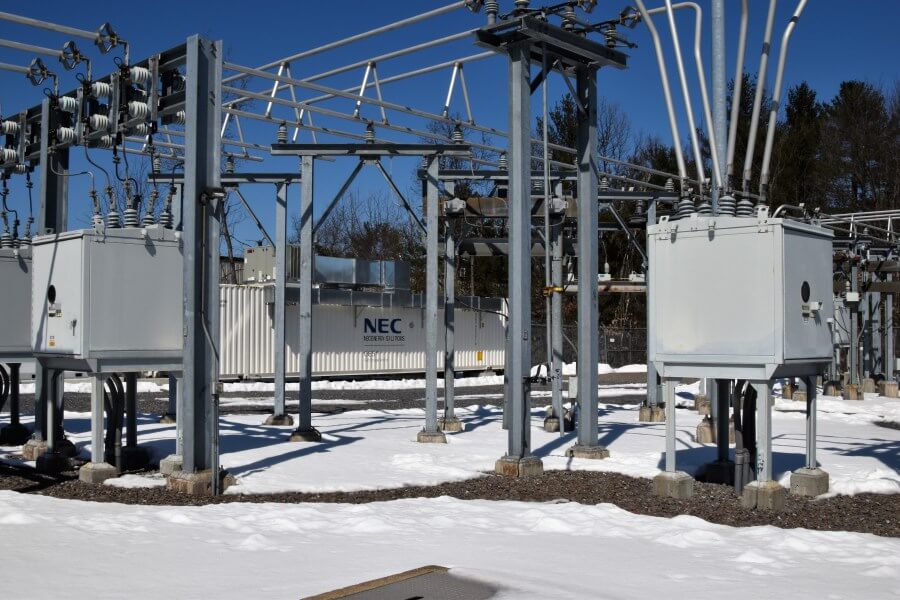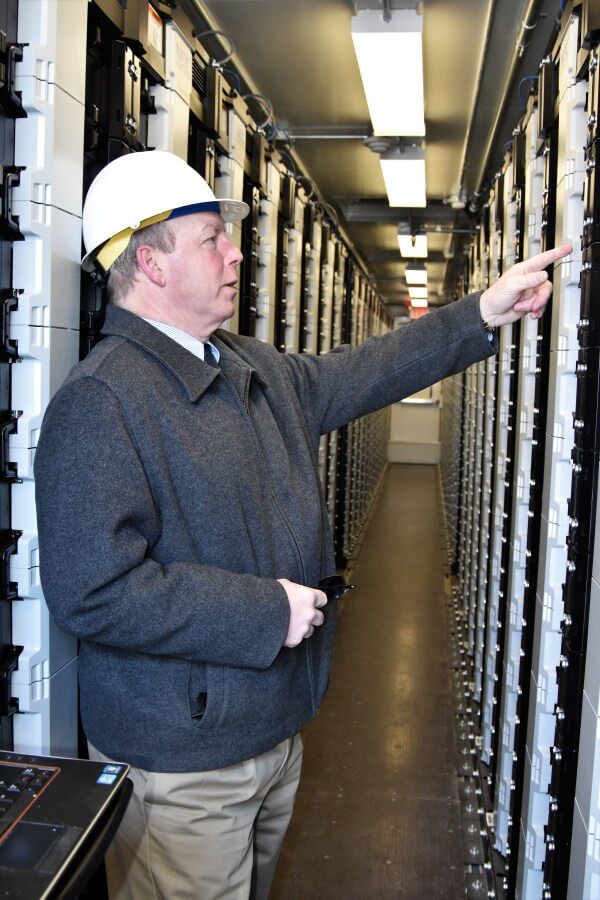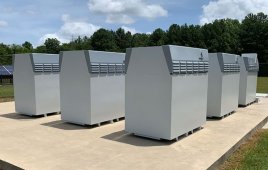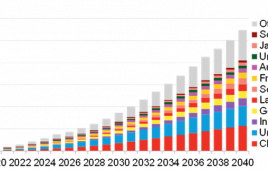Sterling, Mass. Municipal Light Department’s 3.9 MWhr energy storage system will save over $400,000 per year while providing continuous power to first responders
A recent video showcasing the Sterling Municipal Light Department’s award-winning energy storage system premiered yesterday at the Solar Power International/Energy Storage International conference in Las Vegas and at the Innovation Northeast’s Energy Storage & Microgridconference in Boston. The video highlights the municipal utility’s energy storage microgrid, which is bringing both economic and resiliency benefits to the town of Sterling, Massachusetts. The groundbreaking energy storage project is the result of a collaboration among municipal, state, federal, industry, philanthropy, and nonprofit partners.

The battery storage unit sits in the Chocksett Road Substation in Sterling, MA. Photo by Clean Energy Group, March 2017.
The video, produced by Clean Energy Group and the Clean Energy States Alliance, details the economic case for the battery storage system and includes an animation sequence on how the energy storage system works, how it is saving the town of Sterling money, and how it will provide backup power to the town’s police station and emergency dispatch center in the event of a long-duration power outage. The video is available at www.cleanegroup.org/ceg-projects/resilient-power-project/featured-installations/sterling.
The 2-megawatt, 3.9 megawatt-hour battery storage system, installed at the Sterling Municipal Light Department (SMLD) Chocksett Road Substation, is expected to save the town’s ratepayers at least $400,000 per year by decreasing costs associated with capacity and transmission charges from the regional power services supplier, ISO New England. Sterling will be able to lower its demand for grid services from the ISO by discharging the battery system during times of regional peak demand. The project demonstrates a strong investment strategy for municipal energy storage: With the help of grants, this $2.7 million project is expected pay for itself in just over two years; and even without the grants, the payback period would likely be fewer than seven years.

Sean Hamilton, General Manager at the Sterling Municipal Light Department, checks equipment inside the battery storage unit at the Chocksett Road Substation in Sterling, Mass.
According to Sean Hamilton, general manager at SMLD, “Sterling’s energy storage system is proving that energy storage works, and it can save a town substantial money. So far, the system has enabled savings in excess of $350,000 in nine months – these savings will directly benefit Sterling’s ratepayers. More towns need to move in this direction, toward sustainable power; and now is not the time for government agencies to stop helping to make more of these systems possible.”
In addition to the economic benefits, the system can “island” from the grid during a power outage and provide at least 12 days of resilient backup power to the town’s police station and emergency dispatch center, a critical facility providing first responder services. Because Sterling’s battery system is connected to a 2.4 MW solar array, the solar can charge the batteries when grid power is not available, providing an even longer period of energy assurance.
Dr. Imre Gyuk, Energy Storage Program Manager for the U.S. Department of Energy Office of Electricity Delivery and Energy Reliability, said of the project, “There are monetized and unmonetized benefits. Resiliency is a benefit that is more difficult to monetize, but it is equally important.”
The project received a $1.46 million Community Clean Energy Resiliency Initiative grant from the Massachusetts Department of Energy Resources, under Commissioner Judith Judson, with additional financial and technical assistance from the U.S. DOE Office of Electricity under the leadership of Dr. Imre Gyuk, and Sandia National Laboratories under the direction of Dan Borneo. Additional technical support was provided by the Clean Energy States Alliance through its Energy Storage Technology Advancement Partnership (ESTAP), and by Clean Energy Group’s Resilient Power Project through a generous grant from Boston-based Barr Foundation.
“Success is never about a single player; it’s about the team,” said Sean Hamilton, referring to the unique collaboration that occurred to implement this project.
“It’s increasingly important that energy systems are resilient to major storms and other impacts of climate change,” said Mariella Puerto, co-director of Climate at the Barr Foundation. “Sterling is an exciting example of a community taking control and ownership of its system. Through storage, the town now has a clean, cost-efficient, reliable, and resilient energy source.”
“Sterling is in the spotlight because its municipal utility can use the battery system to control rising power costs,” said Clean Energy Group Project Director Todd Olinsky-Paul. “This benefits the town, but the project also provides environmental benefits for the entire New England region. By using batteries to curb electricity demand spikes, the need to call on expensive gas-fired peaker plants is reduced, and the region’s air quality is improved. And when more municipal utilities install batteries, the grid will become more efficient and more resilient.”
The Sterling project has been the recipient of many awards and accolades, including the No. 1 ranking for Utility Energy Storage Annual Watts Per Customer for 2017 in the Smart Electric Power Association’s top ten ranking of U.S. electric utilities, and a 2017 Grid Edge award from Greentech Media. The SMLD project has also garnered international attention with delegations from Europe and Asia visiting the installation.
Additional information on the SMLD project, including analysis, a fact sheet, a photo collection on the SMLD energy storage project, additional quotes about the project, and a link to the video, is available at: www.cleanegroup.org/ceg-projects/resilient-power-project/featured-installations/sterling.
Filed Under: Energy storage




